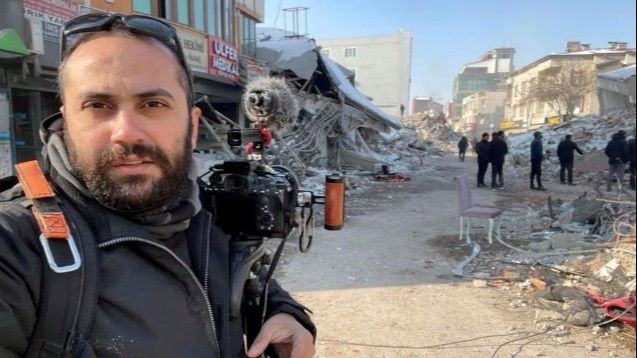Reuters journalist Issam Abdallah killed by Israeli shelling in Lebanon October 2023, likely gunfire, says new report
According to a report, an Israeli tank fired two shells at a clearly identified group of journalists in Lebanon in October last year, and then "likely" opened fire on them with a machine gun in an 1 minute and 45 second attack. The first shell killed Reuters visual journalist Issam Abdallah.

An Israeli tank crew killed a Reuters reporter in Lebanon in October by firing two shells at an identified group of journalists and then “likely” opened fire on them with a heavy machine gun in an attack that lasted 1 minute and 45 seconds, according to a report into the incident published on Thursday.
The report opens a new tab by the Netherlands Organisation for Applied Scientific Research (TNO) – which was contracted by Reuters to analyze evidence from the Oct. 13 attack that killed visuals journalist Issam Abdallah – found that a tank 1.34 km away in Israel fired two 120 mm rounds at the reporters.
The first shell killed Abdallah, 37, and severely wounded Agence France-Presse (AFP) photographer Christina Assi, 28.
A Reuters investigation in December covered TNO’s preliminary finding that a tank in Israel had fired at the journalists. In its final report on Thursday, the institute revealed that audio picked up by an Al Jazeera video camera at the scene showed the reporters also came under fire from 0.50 caliber rounds of the type used by the Browning machine guns that can be mounted on Israel’s Merkava tanks.
“It is considered a likely scenario that a Merkava tank, after firing two tank rounds, also used its machine gun against the location of the journalists,” TNO’s report said. “The latter cannot be concluded with certainty as the direction and exact distance of (the machine gun) fire could not be established.”
Reuters could not independently determine if the Israeli tank crew knew it was firing on journalists, nor whether it also shot at them with a machine gun and, if so, why.
Neither of the two surviving Reuters reporters or another AFP journalist at the scene remembered the machine gun fire. All said they were in shock at the time.
The Israel Defense Forces (IDF) did not respond to requests for comment about any aspect of the attack on journalists. Asked to comment on TNO’s preliminary findings in December, the IDF said: “We don’t target journalists.” A day after the Reuters investigation was published, it said the incident took place in an active combat zone.
International humanitarian law bars attacks on journalists as those in the news media have the full scope of protection granted to civilians and cannot be considered military targets.
“We condemn, in the strongest terms, the attack on an identifiable group of journalists, working in the open. The attack killed our colleague Issam Abdallah and injured several others. We reiterate our calls on Israel to explain how this could have happened and to hold those responsible to account,” Reuters Editor-in-Chief Alessandra Galloni said.
IDENTIFIED AS PRESS
AFP Global News Director Phil Chetwynd reiterated his call for a thorough and transparent investigation by the Israeli military.
“If reports of sustained machine gun fire are confirmed, this would add more weight to the theory this was a targeted and deliberate attack,” he said.
Ihtisham Hibatullah, Al Jazeera’s manager of international communications, urged the Israeli government to disclose the findings of its investigation.
“This incident strongly indicates intentional targeting, as confirmed by investigations, including by TNO,” he said.
Lebanon’s Minister of Information did not respond to a request for comment.
To read the 70-page TNO report, which explains how the independent research institute in The Hague triangulated the firing point of the tank rounds and analyzed the audio of the machine gun fire, click here, and open a new tab.
TNO noted that the seven journalists were wearing blue flak jackets and helmets, most with “PRESS” written on them in white letters. They had been filming cross-border shelling from a distance in an open area on a hill near the Lebanese village of Alma al-Chaab for nearly an hour before the attack.
Video footage of the aftermath of the attack also showed a black car belonging to Reuters marked “TV” in large yellow letters made out of tape on both the hood and the roof.
TNO said there was a clear line of sight from where the tank rounds were fired to the scene of the attack. In the live TV feeds ahead of the attack, one or more drones can be heard and an Israeli helicopter was also visible overhead in some footage.
The institute was able to determine exactly where the two tank rounds came from because it had video of the second round’s muzzle blast and flight, in addition to audio files recorded at the scene of the incident.
TNO’s analysis of the machine gun fire showed that the “only reasonable match” was for a 0.50 caliber weapon fired from 1.34 km away – the same distance as the tank rounds – but the audio recordings were not sufficient to determine the firing point.
However, the fact the bursts of bullets came so quickly after the tank rounds, coupled with the analysis, led TNO to conclude it was “likely” they came from the same place. The independent institute did not offer any other scenario for the origin of the machine gun fire.
About 30 seconds after the second tank round, there was a burst of some 25 shots from a machine gun, followed by bursts of nine and 12 shots. Just over 30 seconds later, there were three shots, then a single shot and a metallic ping, which may have been the bullet hitting a low wall near the camera, TNO said.
Reuters photographer Thaier Al-Sudani, 47 cameraman Maher Nazeh, 53, as well as two journalists from Al Jazeera and another from AFP, were also wounded in the attack.
FULL INQUIRY
Several of the experts who reviewed the TNO report at the request of Reuters expressed divergent views about whether the tank crew had deliberately targeted journalists.
“The TNO report does conclude that it was likely, in addition to the two tank rounds, that machine gun fire came from the same location, and that adds to or compounds the deliberateness with which they seem to have been targeted, directly,” said Jessica Dorsey, an expert in international humanitarian law at Utrecht University.
“And I think that that, from a legal perspective, if this ever got to a courtroom, makes even more of a compelling argument that this was indeed a war crime,” she said.
However, Nick Kaufman, a British-Israeli lawyer who served in the IDF Military Advocate General’s Corps and has defended high-profile clients against war crime charges at international criminal tribunals, said it was still unclear why the tank had fired on the reporters.
“Based on the TNO report alone, it’s not possible to conclude that this was intentional targeting of journalists as opposed to the pursuit of a legitimate military objective which went awry,” he said.
“One would need to have a full inquiry and understand the military intelligence which underlay the deployment of the two rounds.”
The day after the attack, Israel’s military said it had visuals of the incident and it was being investigated. No results have been made public.




